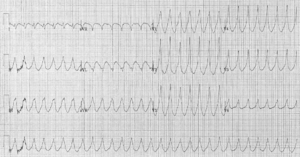Ventricular tachycardia facts for kids

Ventricular tachycardia (V-tach or VT) is a type of tachycardia (a fast heart rate). The heart has four chambers (closed spaces). The top two are called the atria, and the bottom two are called the ventricles. When the heart is working normally, electrical signals in the heart tell the to atria squeeze first. However, in ventricular tachycardia, the ventricles squeeze first. This happens because the electrical signals that tell the atria to squeeze first are not working.
Ventricular tachycardia is a medical emergency. First of all, if the heart is beating too fast, it does not have time to refill with blood between beats. This means that the heart will not be able to squeeze out enough blood to the rest of the body. Most people in ventricular tachycardia have a heart rate of at least 170 beats per minute. This is very fast. (A normal heart rate is 60-100.)
Ventricular tachycardia can also cause low blood pressure. If the blood pressure gets low enough, important parts of the body, like the brain, will not get enough blood and oxygen to survive.
Ventricular tachycardia can also lead to ventricular fibrillation, asystole (where the heart stops beating), and sudden death.
Contents
Symptoms
The most common symptoms of ventricular tachycardia are feeling dizzy, having palpitations (feeling the heart pounding inside the chest), having trouble breathing, or chest pain. Some people with ventricular tachycardia do not have any symptoms, especially if the V-tach lasts for only a few seconds.
When a person's heart rate is very high, or the ventricular tachycardia lasts for more than a few seconds, the person may faint or become unconscious because their brain is not getting enough blood and oxygen. In the worst cases, their heart may stop, or they may die.
Diagnosis
A doctor can diagnose ventricular tachycardia by doing an electrocardiogram (also called an ECG or an EKG). This is a test that shows the electrical activity in the heart. The doctor will be able to see that the electrical signals that tell the atria to squeeze first are not working.
Treatment
Ventricular tachycardia can be treated in a few different ways. Treatment depends on whether the patient still has a pulse. If the patient is in pulseless ventricular tachycardia, their heart is beating so fast that it cannot squeeze out any blood.
Cardioversion
If a person still has a pulse, ventricular tachycardia can usually be stopped through cardioversion. Cardioversion means using medication or an electric shock to make the heart start beating normally again.
Defibrillation
If a person has pulseless ventricular tachycardia, they need to be shocked with a defibrillator.
Two different types of defibrillators can be used. An external defibrillator is a machine that delivers a shock through two sticky pads that are placed on the person's chest.
However, some people who have already been diagnosed with V-tach have surgery to put a defibrillator inside their chest. This is called an implantable cardioverter-defibrillator (ICD). This type of defibrillator shocks the heart automatically when it goes into V-tach.
First aid
If a person goes into pulseless ventricular tachycardia, first aid can be helpful. 9-1-1 or the local emergency telephone number should be called immediately. Then - like in any situation where a person suddenly becomes unconscious and has no pulse - cardiopulmonary resuscitation (CPR) should be started right away. An emergency medical dispatcher can help explain how to do CPR until an ambulance gets there.
Causes
Ventricular tachycardia can be caused by many different things. The most common cause is ischemic heart disease (heart disease that causes the heart to not get enough oxygen).
Ventricular tachycardia can also be caused by other problems, like:
- Cardiomyopathies (diseases that affect the heart muscle)
- Diseases like sarcoidosis and rheumatoid arthritis that can affect the whole body, if they attack the heart muscle
- Problems with electrolytes, like not having enough potassium, calcium, or magnesium
- Certain kinds of medications
Sometimes doctors cannot find a cause for ventricular tachycardia. This is called idiopathic ventricular tachycardia.
Prognosis
Ventricular tachycardia causes most of the sudden cardiac deaths in the United States. It causes about 300,000 deaths every year.
The chance of sudden death is highest for people who:
- Have ischemic cardiomyopathy (their heart muscle was damaged by not getting enough oxygen); and
- Have ventricular tachycardia that comes and goes
The chance of sudden death is lowest for people with idiopathic ventricular tachycardia.
Even for high-risk people, treatment with medications like beta blockers can help. So can implantable cardio-defibrillators.
Related pages
See also
 In Spanish: Taquicardia ventricular para niños
In Spanish: Taquicardia ventricular para niños

